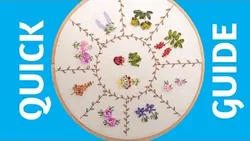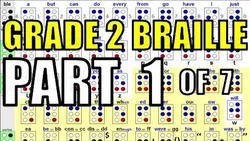
Hand Embroidery: Beginners guide 
This course is a beginner's guide to hand embroidery. It covers 10 hand embroidery flowers stitching tutorials, 10 ribbon embroidery flowers for beginners, 10 hand embroidery filling stitches in 20 minutes, and 10 embroidered flowers stitch by DIY stitching. It also includes top 12 stitches in hand embroidery for beginners. This course is perfect for those who want to learn the basics of hand embroidery and develop their skills. ▼
ADVERTISEMENT
Course Feature
![]() Cost:
Cost:
Free
![]() Provider:
Provider:
Youtube
![]() Certificate:
Certificate:
Paid Certification
![]() Language:
Language:
English
![]() Start Date:
Start Date:
On-Demand
Course Overview
❗The content presented here is sourced directly from Youtube platform. For comprehensive course details, including enrollment information, simply click on the 'Go to class' link on our website.
Updated in [May 25th, 2023]
This course, Hand Embroidery: Beginner's Guide, provides an introduction to the art of hand embroidery. It covers 10 hand embroidery flowers stitching tutorials, 10 ribbon embroidery flowers for beginners, 10 hand embroidery filling stitches in 20 minutes, 10 embroidered flowers stitch by DIY stitching, and the top 12 stitches in hand embroidery for beginners. Participants will learn the basics of hand embroidery and gain the skills to create beautiful embroidered flowers.
[Applications]
After completing this course, participants can apply their newfound knowledge of hand embroidery to create beautiful and unique pieces of art. They can use the 10 hand embroidery flowers stitching tutorial to create intricate designs, or the 10 ribbon embroidery flowers for beginners to create more simple designs. They can also use the 10 hand embroidery filling stitches in 20 minutes to create more complex designs. Additionally, they can use the 10 embroidered flowers stitch by DIY stitching to create unique designs. Finally, they can use the top 12 stitches in hand embroidery for beginners to create even more intricate designs. With the knowledge gained from this course, participants can create beautiful pieces of art that will last a lifetime.
[Career Paths]
1. Embroidery Designer: Embroidery designers create unique designs for clothing, accessories, and other items. They use a variety of techniques, such as hand embroidery, machine embroidery, and appliqué, to create their designs. As technology advances, embroidery designers are increasingly using computer-aided design (CAD) software to create their designs.
2. Embroidery Technician: Embroidery technicians are responsible for setting up and operating embroidery machines. They must be familiar with the different types of machines and their functions, as well as the different types of fabrics and threads used in embroidery. They must also be able to troubleshoot any problems that may arise during the embroidery process.
3. Embroidery Instructor: Embroidery instructors teach students the basics of hand embroidery, machine embroidery, and appliqué. They must be knowledgeable about the different types of fabrics and threads used in embroidery, as well as the different types of stitches and techniques. They must also be able to provide guidance and instruction to their students.
4. Embroidery Business Owner: Embroidery business owners are responsible for running their own embroidery business. They must be knowledgeable about the different types of fabrics and threads used in embroidery, as well as the different types of machines and their functions. They must also be able to manage their business, including marketing, customer service, and financial management. As technology advances, embroidery business owners are increasingly using computer-aided design (CAD) software to create their designs.
[Education Paths]
1. Bachelor of Fine Arts in Textile Design: This degree program focuses on the design and production of textiles, including hand embroidery. Students learn about the history of textiles, the principles of design, and the techniques of hand embroidery. They also learn about the latest trends in the industry, such as digital printing and computer-aided design.
2. Master of Arts in Textile Design: This degree program focuses on the design and production of textiles, including hand embroidery. Students learn about the history of textiles, the principles of design, and the techniques of hand embroidery. They also learn about the latest trends in the industry, such as digital printing and computer-aided design.
3. Master of Science in Textile Design: This degree program focuses on the design and production of textiles, including hand embroidery. Students learn about the history of textiles, the principles of design, and the techniques of hand embroidery. They also learn about the latest trends in the industry, such as digital printing and computer-aided design.
4. Doctor of Philosophy in Textile Design: This degree program focuses on the design and production of textiles, including hand embroidery. Students learn about the history of textiles, the principles of design, and the techniques of hand embroidery. They also learn about the latest trends in the industry, such as digital printing and computer-aided design. Additionally, they explore the development of new materials and technologies for the production of textiles, as well as the ethical and environmental implications of textile production.
Course Provider

Provider Youtube's Stats at AZClass
Discussion and Reviews
0.0 (Based on 0 reviews)
Explore Similar Online Courses

Cloud Foundry Primer

Grade 2 Braille

Python for Informatics: Exploring Information

Social Network Analysis

Introduction to Systematic Review and Meta-Analysis

The Analytics Edge

DCO042 - Python For Informatics

Causal Diagrams: Draw Your Assumptions Before Your Conclusions

Whole genome sequencing of bacterial genomes - tools and applications

How to do stitching&how to make an embroidery design

Introduction to Freehand Machine Embroidery


Start your review of Hand Embroidery: Beginners guide